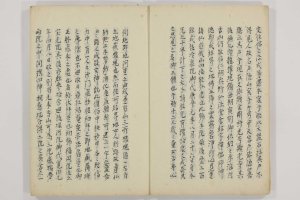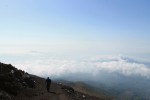Part of my research this year has been devoted to a text entitled The Transmitted Account of Kenkō-ji of Mt. Togakushi (Togakushi-san Kenkō-ji ruki 戸隠山顕光寺流記), compiled by the monk, Jikkokusō Ujō 十穀僧有通, in 1458.
Among the many vivid aspects it provides on the religious culture at Mt. Togakushi in the mid-fifteenth century, a passage I came across on the mountain’s practice of nyonin kekkai 女人結界 (a boundary prohibiting women) especially sparked my interest. With some help from my research advisor, Suzuki Masataka (who’s written extensively on the practice) and medieval Buddhist scholar, Iyanaga Nobumi, I came up with a translation for the following passage:
“On the twenty-sixth day of the eighth month of the first year of the Kōhei 康平 era (1058), during the reign of Goreizei-in 後冷泉院, a bright light was radiating out from atop a giant tree fifty cho 町 from Honnin [now Okusha of Togakushi-san].[1] It seemed like a mysterious and unusual living being. The image was that of a divine true body (mishōtai 御正躰).
At that time, there was a young girl of twelve to thirteen years of age in such mental and physical agony that she passed out on the ground. When asked why, she said, “I am the avatar of Jizō 地蔵, the greatest of the three avatars of this mountain, who stands on the left side.[2] That area is a bordered land (kekkai chi 結界地), upon which the trace of women has been removed. Because this defies the Buddha’s orders and ignores his original vow, the benefits of conversion are shallow and scarce. Please erect a building in this place and have me installed.”
Many had their doubts. They insisted that if this was really the divine oracle [of Jizō], then have [the bright light] moved into the sleeve of someone among the priests and laity. Then, it flew down into the sleeve of a śramaṇa among them who had great faith. He worshiped it, [making it] the site of the honored form of the bodhisattva Jizō. Not moving for days, he built a shrine with an attached hermitage. It became a hut in which to pursue the Dharma.
The place where the divine true body [of Jizō] flew down is called Fushigami 伏拝. The temple was first named Fukuokain 福岡院 and later became known as Hōkōin 寶光院 [now Hōkōsha of Togakushi].”

The alleged tree at Fushigami where a bright light radiated from above and a young girl below fell under the possession of the bodhisattva Jizō (though this tree was probably planted later – Edo period?).
Nyonin kekkai became widespread among sacred mountains in the medieval period so it’s no surprise that the practice was adopted at Togakushi-san as well. What is fascinating here is the apparent critique of it at Togakushi in the comment–voiced by Jizō–that it defies the Buddha’s vow (it’s said that Sakyamuni welcomed both men and women into the sangha). As a result, conversion to Buddhism at the mountain provides limited benefit.
Is this Jikkokusō Ujō’s own opinion inserted into the text or does it reflect a wider spread sentiment? Whatever the case, its uncommon to see a critique of the practice coming from within a religious community in premodern Japan. Max Moerman (Localizing Paradise, 2005) discusses other examples, but this one seems particularly pronounced.
Fushigami (literally, to “lie down and worship”), an allusion to the Kumano site of Fushigami, is marked to this day on the old path (古道) between Togakushi’s Hōkōsha and Chūsha shrines. Given the geography of the mountain, this would mean that Hōkōin accepted women while the temple complexes of Chūin (now Chūsha) and Okuin (now Okusha) remained off-limits at this time.
The boundary was later moved in 1795, as evident from an engraved stone marker still standing in between Chūsha and Okusha. (Here’s a Japanese map of the shrines of Togakushi.) The practice was abolished in the Meiji period.
It’s anyone’s guess as to why the boundary was moved between the medieval and early modern periods. The erection of the stone nevertheless, suggests that the rule may have not been strictly enforced up until then. Why after all, reestablish a rule if no one is breaking it?











